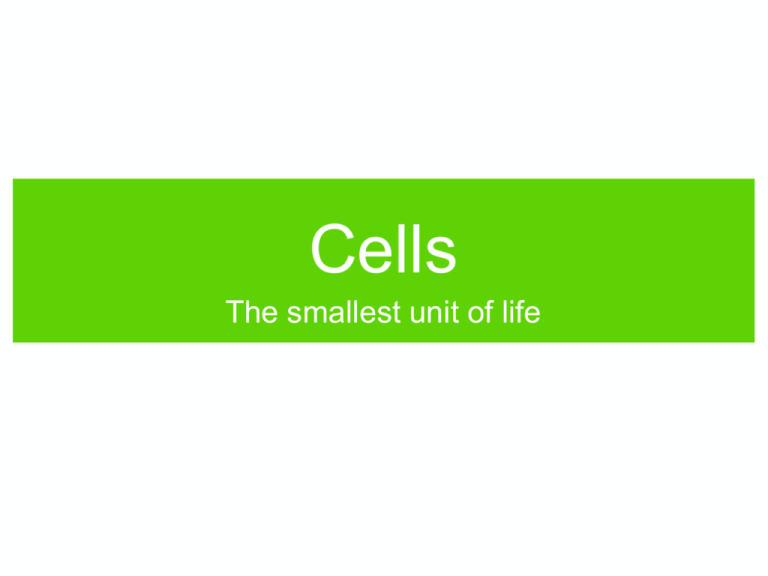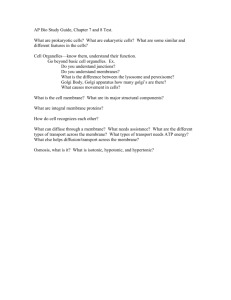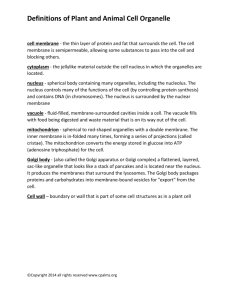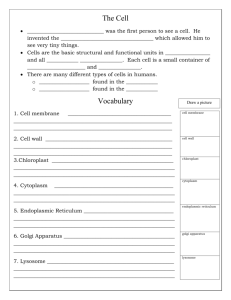
Cells
The smallest unit of life
Which of these is the smallest
object?
33%
1.
2.
3.
4.
5.
33%
33%
Human cell
Protein molecule
Virus
Bacteria
Amino acid
0%
1
2
0%
3
4
5
Prokaryotic organisms lack a nucleus in their cells.
Which of these organisms is prokaryotic?
33%
33%
33%
1. Plants
2. Fungi
3. Protists (such as
Amoeba and
Paramecium)
4. Bacteria
0%
1
2
3
4
Which of these objects can be seen with the aid of an
ordinary student microscope?
100%
1.
2.
3.
4.
Human cell
Virus
Protein molecule
Oxygen atom
1
0%
0%
2
3
0%
4
Which of these is made up of
cells?
100%
1.
2.
3.
4.
5.
Animals
Plants
Fungi
Bacteria
Only animals and
plants
6. All of these
0%
1
0%
0%
0%
2
3
4
0%
5
6
Discovering the Cell
1665 - Robert Hooke
Anton van Leeuwenhoek late 17th, early 18th
centuries
• 1839 – Cell Theory is proposed
independently by Theodore Schwann
and Matthias Jakob Schleiden.
• Cell Theory:
• The cell is the fundamental structure of all living
things.
• All living things are made of cells.
• Cells arise from pre-existing cells through cell
division.
Ernst Ruska - 1938
Light micrograph
Paramecium
Scanning electron
micrograph
Transmission electron
micrograph
Cell Membrane
Scanning electron
micrograph
Prokaryotic Cells
Prokaryotic Features
• No membrane-bound organelles, such
as a nucleus.
• DNA in one large ring-shaped
chromosome
• An enormous variety of metabolic
pathways.
• Highly successful and adaptable.
External structure
Coccus (spherical)
Spirillus (spiral)
Bacillus (rod-shaped)
Internal Structure
chromosome
(nucleoid region)
pili
ribosomes
food granule
prokaryotic
flagellum
capsule or
slime layer
cell wall
plasma membrane
cytosol
plasmid (DNA)
True or False: A virus is a kind
of bacteria.
75%
1. True
2. False
25%
1
2
Viruses
• A virus is usually
not considered
living.
• A virus consists
only of a protein
coat (sometimes
with a lipid outer
layer) and a piece
of genetic material
(DNA or RNA).
Bacteria vs. Virus
Features
Bacteria Virus
Reproduces independently?
Yes
No
Has genetic material?
Yes
Yes
Has cell membrane?
Yes
No
Has metabolism?
Yes
No
Living?
Yes
No
Which of these does a bacteria
NOT have?
1.
2.
3.
4.
75%
DNA
Cell membrane
Nucleus
Bacteria have
none of these.
25%
0%
1
2
0%
3
4
Eukaryotic Cells
Eukaryotic Features
• Cells contain membrane-bound
organelles.
• Nucleus holds multiple strands of DNA,
which condense into chromosomes
during cell division.
• May be single-celled or multi-cellular
organisms.
Animal cell
nuclear pore
chromatin (DNA)
nucleolus
nuclear envelope
cytosol
nucleus
centriole
rough endoplasmic
reticulum
plasma
membrane
lysosome
ribosomes on
rough ER
smooth
endoplasmic
reticulum
free ribosome
mitochondrion
Figure 4-3 Biology: Life on Earth 8/e ©2008 Pearson Prentice Hall, Inc.
Golgi apparatus
vesicle
Plant Cell - same organelles as an animal
cell, plus a few more
plastid
mitochondrion
choloroplast
cytosol
Golgi apparatus
smooth
endoplasmic
reticulum
central vacuole
vesicle
plasmodesma
rough
endoplasmic
reticulum
cell wall
plasma
membrane
nuclear pore
nucleus
chromatin (DNA)
nucleolus
nuclear envelope
ribosomes
free ribosome
Things we will see in cells
• First let’s focus on things we can see
using a light microscope and ordinary
stains:
• Cell nucleus
• Cell membrane
• Cell wall
• Plastids (Chloroplast, amyloplast,
chromoplast)
• Plant cell vacuole
Nucleus
nuclear
envelope
nucleolus
nuclear
pores
chromatin
Cell Wall
secondary
cell wall
primary
cell wall
plasma
membrane
middle
lamella
Chloroplast
outer
membrane
inner
membrane
stroma
thylakoid
channel
interconnecting
thylakoids
granum
(stack of thylakoids)
1 micrometer
Amyloplasts and other plastids
plastid
starch
globules
0.5 micrometer
W
O
R
K
• How is the cell wall of plant cells similar
to an animal’s skeleton? How is it
different?
T
O
G
E
T
H
E
R
Protein-making Machinery
• Information for making proteins is in
DNA, stored in the nucleus.
• An RNA copy is made in the nucleus and
sent out to the rough Endoplasmic
Reticulum (ER).
• Proteins leave the ER and are finished
and packaged in the Golgi apparatus.
Endoplasmic Reticulum
ribosomes
rough ER
vesicles
smooth ER
Golgi Apparatus
Protein-carrying
vesicles from ER
merge with Golgi
apparatus
Golgi
apparatus
Vesicles carrying
modified protein
leave Golgi apparatus
ER and Golgi function
5 Vesicles merge with the
plasma membrane and
release protein by
exocytosis.
4 Completed protein
is packaged into
vesicles.
3 Vesicles fuse with Golgi. The
protein may be altered and finished.
2 Protein is packaged
into vesicles and travels
to Golgi apparatus.
1 A protein is
synthesized in the rough ER.
A cell that produces a lot of
protein must have an extensive:
75%
1.
2.
3.
4.
Nucleus
Rough ER
Smooth ER
Golgi apparatus
25%
0%
1
2
3
0%
4
Proteins are packaged for
delivery by the:
75%
1. Nucleus
2. Rough ER
3. Golgi apparatus
25%
0%
1
2
3
• Discuss and summarize in your own
words the roles of:
• the cell nucleus
• the rough ER
• the Golgi complex
W
O
R
K
T
O
G
E
T
H
E
R
Organelles in Cell Energy
• Chloroplasts capture energy from the
sun and use that energy to manufacture
sugars (chemical energy storage).
• Mitochondria break the bonds in sugars
and release the energy that was stored
there.
Mitochondrion
outer
membrane
inner
membrane
matrix
cristae
intermembrane
compartment
0.2 micrometer
True or false: Plant cells are much more primitive than
animal cells and have far fewer types of organelles.
50%
50%
1. True
2. False
1
2
Plant cells are:
50%
50%
1. Eukaryotic
2. Prokaryotic
1
2
What do chloroplasts do?
33%
33%
33%
1. Make energy
2. Use energy to make
molecules.
3. Break sugar down
to release energy.
1
2
3
W
O
R
K
• Chloroplasts carry out photosynthesis to
make sugars and other monomers.
What does the plant use these
monomers for?
T
O
G
E
T
H
E
R
Single-Celled Organisms
• Single-celled organisms carry out the
same functions that our multicellular
bodies do, but all within a single cell.
How do they do it?
One-celled Eukaryotic organisms have unique challenges.
A Paramecium must:
ingest food
excrete waste
sense and respond
to the environment
(a) Cilium
propulsion of fluid
power stroke
plasma membrane
return stroke
(b) Flagellum
direction of locomotion
propulsion of fluid
continuous propulsion
protein
"arms"
central pair of
microtubules
section of cilium
(transmission EM)
Paramecium
plasma membrane
basal body
0.1 micrometer
cilium
contractile
vacuole
full reservoir
contracted reservoir
Water enters collecting ducts,
fills central reservoir.
collecting
ducts
central
reservoir
pore
Reservoir contracts, expelling
water through pore.
• In a one-celled organism, which
organelle is most like:
• A stomach (assists with digestion)?
• A kidney (removes excess water)?
W
O
R
K
T
O
G
E
T
H
E
R
Recap
• Prokaryotic cells have no membranebound organelles.
• Eukaryotic cells have membrane-bound
organelles, which compartmentalize
processes for better efficiency.
• ALL cells have a cell membrane and
DNA.








